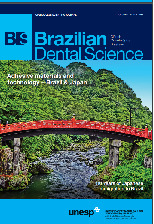Prevalence of foramen tympanicum (or of huschke) in a brazilian population: a cone beam computed tomography study
DOI:
https://doi.org/10.14295/bds.2018.v21i2.1538Resumo
Objective: To study the prevalence of foramen of Huschke (FH) or foramen tympanicum (FT) in a Brazilian population by means of cone beam computed tomography (CBCT). Material & Methods: 303 tomographic examinations were selected from an oral radiology clinic’s archive, totalising 606 temporomandibular joints (TMJs), all acquired with an I-CAT CBCT scanner (Next Generation, Imaging Science International, Hatfield, PA, USA) operating at voxel size of 0.25 mm and field of view (FoV) between 6.0 to 8.0-cm height to encompass the mid-third of the face. The images were analysed by using XORAN software (Xoran Technologies, Ann Arbor, Michigan, USA) on a multiplanar reconstruction window, in which the entire tympanic region (right and left) was individually scanned in the supero-inferior orientation for presence of FH through axial sections. Results: Considering the total sample, we observed a prevalence of 14 foramens (2.27%), with FT being more prevalent in females than in males (respectively, 1.46 % and 0.81%); as for age, we found a higher prevalence of FT in males aged between 0 and 20 years old (0.33%) and in females older than 70 years old (0.66%); and as for the affected side, that is, presence of unilateral or bilateral FT, we found that 0.65% of the examinations had unilateral FT, whereas 1.62% had bilateral FT. Conclusion: FT had a prevalence of 2.27% in our sample, with females being more affected than males and highly prevalent (0.66%) in women older than 70 years old.
Downloads
Downloads
Publicado
Como Citar
Edição
Seção
Licença
TRANSFERÊNCIA DE DIREITOS AUTORAIS E DECLARAÇÃO DE RESPONSABILIDADE
Toda a propriedade de direitos autorais do artigo "____________________________________________________________________" é transferido do autor(es) para a CIÊNCIA ODONTOLÓGICA BRASILEIRA, no caso do trabalho ser publicado. O artigo não foi publicado em outro lugar e não foi submetido simultaneamente para publicação em outra revista.
Vimos por meio deste, atestar que trabalho é original e não apresenta dados manipulados, fraude ou plágio. Fizemos contribuição científica significativa para o estudo e estamos cientes dos dados apresentados e de acordo com a versão final do artigo. Assumimos total responsabilidade pelos aspectos éticos do estudo.
Este texto deve ser impresso e assinado por todos os autores. A versão digitalizada deverá ser apresentada como arquivo suplementar durante o processo de submissão.




























